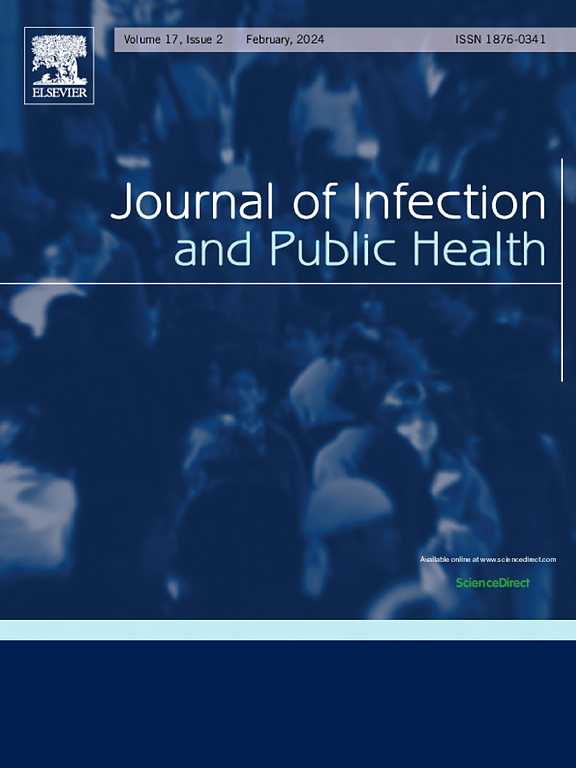探索雪腐镰刀菌的基因组潜力,寻找抗耐多药结核分枝杆菌的抗菌代谢物
IF 4.7
3区 医学
Q1 INFECTIOUS DISEASES
引用次数: 0
摘要
多用途裂殖酸球菌(Kytococcus schroeteri)以产生推测的次级代谢物而闻名。其中包括抗菌素和其他具有治疗意义的化合物。抗生素耐药性病原体的出现使得人们有必要探索新型候选药物的可能来源。本研究的重点是挖掘 schroeteri 葡萄球菌的基因组,通过生物合成基因簇探索其次生代谢物。研究通过硅内方法分析了这些次生代谢物的类药物特性,并评估了它们作为抗菌剂的潜力。在该细菌的两个菌株(H01 和 UMB1298)中发现了八个生物合成基因簇。在这些基因簇中独特的 49 种代谢物中,根据利平斯基五选一规则选出了 13 种代谢物。研究人员对这些代谢物的理化性质、药代动力学分析、毒性特征和人体靶标进行了预测,并研究了它们与结核杆菌的 RpfB 蛋白(潜伏结核病的致病因子)之间的关键相互作用。据预测,所有代谢物都是无毒的,不会抑制任何人类蛋白质。几种代谢物(包括一部分巴西兰)显示出较低的急性毒性,并有望与 RpfB 蛋白的关键残基 GLU292 发生相互作用。通过对其中一种复合物进行 100 ns MD 模拟,验证了配体与 RpfB 的相互作用亲和力。RMSD、RMSF和结合能计算结果表明,配体与受体蛋白之间存在稳定的相互作用,这为开发抗生素耐药性新药提供了可能。本研究发现的假定代谢物不仅具有分子特性,还具有支持生理兼容性的特征。这也提高了它们作为治疗性抗菌替代品的潜在有效性。对我们的计算结果进行实验验证,可能会为探索 K. schroeteri 生产新型化合物的潜力开辟一条途径,以对抗结核杆菌的抗生素耐药性。本文章由计算机程序翻译,如有差异,请以英文原文为准。
Exploring the genomic potential of Kytococcus schroeteri for antibacterial metabolites against multi-drug resistant Mycobacterium tuberculosis
The versatile bacterium Kytococcus schroeteri is known for producing putative secondary metabolites. These include antimicrobials and other therapeutically significant compounds. The emergence of antibiotic-resistant pathogens has necessitated the exploration of possible sources for novel drug candidates. This study focuses on the genome mining of Kytococcus schroeteri to explore its secondary metabolites through biosynthetic gene clusters. It analyzes their drug-like properties through in-silico methods and evaluates their potential as antimicrobial agents. Eight biosynthetic gene clusters were identified in two strains (H01 and UMB1298) of this bacterium. Among the unique 49 metabolites from these clusters, 13 metabolites were selected according to the Lipinski rule of five. Physiochemical properties, pharmacokinetic analysis, toxicity profiles, and human target predictions of these metabolites were performed, and they were examined for crucial interactions with M. tuberculosis’s RpfB protein, the causative agent of latent tuberculosis. All metabolites were predicted to be non-toxic and did not inhibit any human proteins. Several metabolites, including a subset of brasilanes, exhibited both low acute toxicity and promising interactions with GLU292, the critical residue of the RpfB protein. The interaction affinity of the ligands with RpfB was validated by subjecting one of the complexes to a 100 ns MD simulation. The RMSD, RMSF, and binding energy calculations indicated a stable interaction of the ligand with the receptor protein, which raised the possibility of novel drugs to combat antibiotic resistance. The putative metabolites identified in this study not only exhibit molecular properties but also possess characteristics that support physiological compatibility. It also heightens their potential effectiveness as therapeutic antibacterial alternates. The experimental validation of our computational results may open an avenue to explore the potential of K. schroeteri for producing novel compounds to combat the antibiotic resistance in M. tuberculosis.
求助全文
通过发布文献求助,成功后即可免费获取论文全文。
去求助
来源期刊

Journal of Infection and Public Health
PUBLIC, ENVIRONMENTAL & OCCUPATIONAL HEALTH -INFECTIOUS DISEASES
CiteScore
13.10
自引率
1.50%
发文量
203
审稿时长
96 days
期刊介绍:
The Journal of Infection and Public Health, first official journal of the Saudi Arabian Ministry of National Guard Health Affairs, King Saud Bin Abdulaziz University for Health Sciences and the Saudi Association for Public Health, aims to be the foremost scientific, peer-reviewed journal encompassing infection prevention and control, microbiology, infectious diseases, public health and the application of healthcare epidemiology to the evaluation of health outcomes. The point of view of the journal is that infection and public health are closely intertwined and that advances in one area will have positive consequences on the other.
The journal will be useful to all health professionals who are partners in the management of patients with communicable diseases, keeping them up to date. The journal is proud to have an international and diverse editorial board that will assist and facilitate the publication of articles that reflect a global view on infection control and public health, as well as emphasizing our focus on supporting the needs of public health practitioners.
It is our aim to improve healthcare by reducing risk of infection and related adverse outcomes by critical review, selection, and dissemination of new and relevant information in the field of infection control, public health and infectious diseases in all healthcare settings and the community.
 求助内容:
求助内容: 应助结果提醒方式:
应助结果提醒方式:


